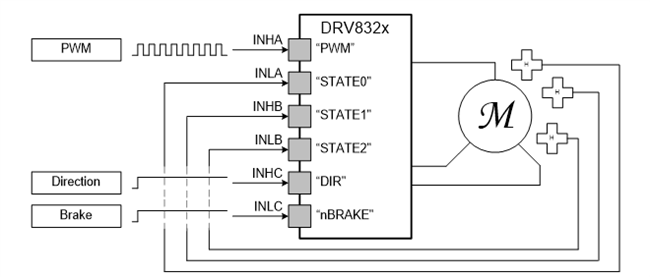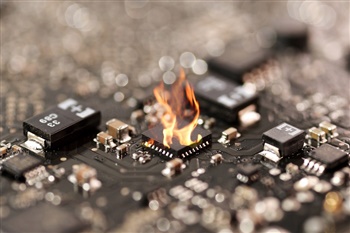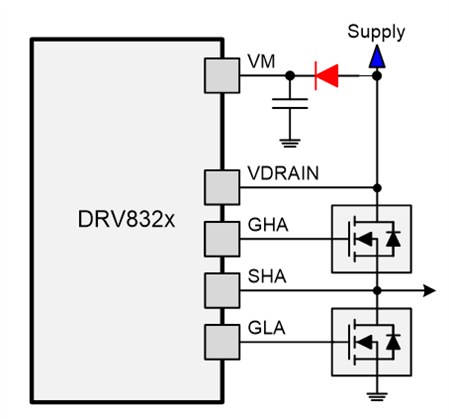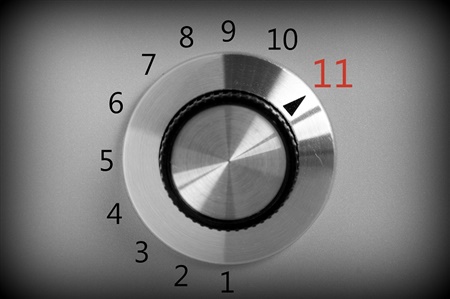SSZT974 august 2017 DRV8305-Q1 , DRV8323 , DRV8323R
There are two absolute truths that I have come to know. First, brushless-DC motor drivers are cool. Everyone loves the thrill of spinning motors, and brushless-DC motors amp up the wow factor by being high speed, high power and high efficiency. Second, engineers like to be creative. Sometimes, they try to get very, very innovative in their solutions to design problems. Sometimes, they may get a little bit too innovative for their own good. In this post I will discuss a few odd, out-of-the-box uses for brushless-DC drivers that I find can be strangely informative to talk about (Figure 1).
 Figure 1 A Depiction of Myself Exiting
the Realms of Sanity
Figure 1 A Depiction of Myself Exiting
the Realms of Sanity1. “Brushless,” You Say?
Three-phase drivers are brushless-DC motor drivers … mostly. These devices integrate three integrated half-bridge gate drivers, which are traditionally associated with controlling a brushless-DC motor, but you can use these outputs to drive pretty much whatever kind of load you want. One common thing to do is drive three solenoids or relays using the three half bridges. Or you can drive two brushed-DC motors between the three phases, like the Automotive 2-Axis Power Seat Brushed DC Motor Drive Reference Design, which uses the DRV8305-Q1. Unfortunately, the marketing team was not enthusiastic about the prospect of calling DRV832x “brushless-DC-gate-driver-or-solenoid-driver-or-dual-brushed-DC-motor-driver-or-whatever-you-want-to-drive-we-don’t-really-care.” But, you get the point about how versatile these drivers can be.
2. Look Ma, No MCU!
Brushless-DC motors are hard. You often need to deal with a lot of code just to get the darn thing to start spinning. To make life a little less depressing, someone came up with an input mode called 1x PWM. This mode is interesting because you can tie Hall sensor inputs directly back into the driver, and it will spin the motor (see Figure 2). It’s a quick and easy way to spin a sensored brushless-DC motor without much know-how. It’s not the most high-performance solution, but it works. You can read more about 1x PWM mode in the DRV832x datasheet. (You can also take a look at some other great parts specifically made to drive brushless-DC motors without a microcontroller [MCU], without Hall sensors and with sinusoidal drive.)
 Figure 2 Drop in and Spin!
Figure 2 Drop in and Spin!3. Stupid-proofing
If I had a dollar for every board that I had destroyed by plugging in the power backwards, I would be very rich and happy. Instead, all that I have are bleak memories of releasing the “magic smoke” from hundreds of integrated circuits and passive components (why, electrolytic capacitors, why!?). But there is something that you can do to protect your innocent circuits from yourself (Figure 3). You can actually implement reverse-supply protection using a seventh field-effect transistor (FET) controlled by the charge pump included on the brushless-DC driver. This application note, “Backwards Batteries: Protecting Automotive Motor-Drive Systems from Reverse Polarity Conditions,” explains how you would go about protecting your board from yourself.
 Figure 3 Every Day, Thousands of Helpless Components Are Injured or Killed through Improper Use; Learn What You Can Do to Help at training.ti.com
Figure 3 Every Day, Thousands of Helpless Components Are Injured or Killed through Improper Use; Learn What You Can Do to Help at training.ti.com 4. Who Needs a Supply Anyway?
Did you know that you can operate some brushless-DC motor drivers down to 0V? It’s only a slight overstatement, but this device can be operational even if the motor supply suddenly goes away, albeit for a short time. It turns out, if you add just a simple diode in series with the driver supply pin (see Figure 4), the device can stay operational for a transient duration in the event that the supply voltage drops out. This is a nice way to operate the driver through quick battery droops due to high current loads. Not all brushless-DC motor drivers can do this however. Only ones that include separated supply (VM) and protection (VDRAIN) pins can operate off a filtered supply. Prominent examples of supported devices include the DRV832x.
 Figure 4 A Little Diode Goes a Long Way
Figure 4 A Little Diode Goes a Long Way5. More Power, More Problems
You can find really low RDS(on) FETs. I mean really, really low. But sometimes, even the lowest of the low is not good enough. For some applications, you need to parallel up FETs to enable 1kW or even higher power to the motors (Figure 5). While this is something that you can do with the many brushless-DC gate drivers, there is a common design pitfall that people stumble into: when you put FETs in parallel, they will not be perfectly matched. This causes the FETs to “ring” against each other, causing oscillations. There is an easy fix, however – just stick a small resistor between the FET gates. You can see an example of a parallel FET design done right on the 18V/1kW, 160A Peak, >98% Efficient, High Power Density Brushless Motor Drive Reference Design.
 Figure 5 Sometimes, You Need to Crank the Power up to 11
Figure 5 Sometimes, You Need to Crank the Power up to 116. Sense & Sensibility (or a Lack Thereof)
I may be a little bit inhibited when it comes to common sense, but that’s not the topic of discussion right now. Sense resistors are used in brushless-DC motor drive systems in order to measure the motor current. Normally, a sense or shunt amplifier will gain up the voltage across the sense resistor, and then send that information to the system MCU for processing. (TI has a few good examples of current sense amplifiers). The DRV8323 and DRV8323R actually have a unique mode of operation where the low-side FET acts as the “sense resistor.” The voltage across the low-side FET is amplified and provided as an output to the MCU. The advantage here would be eliminating the very large sense resistor components. The disadvantage is that the FETs normally have a higher variation on their resistance compared to dedicated sense resistors.
Additional Resources
- View the DRV832x datasheet
- Browse some of TI’s brushless-DC motor drivers with integrated control.
- Take a look at some of our brushless-DC reference designs.